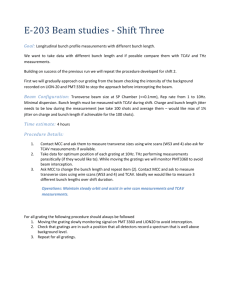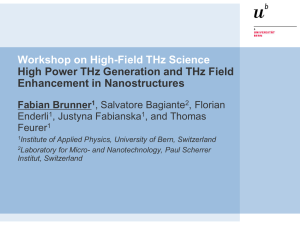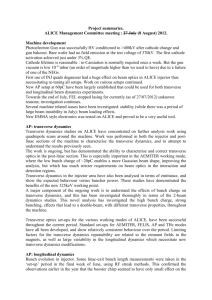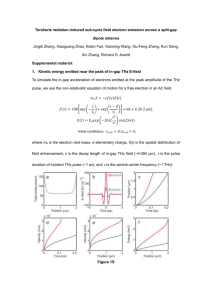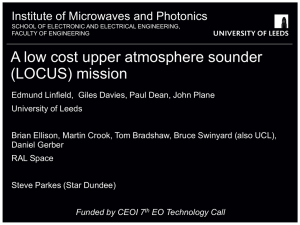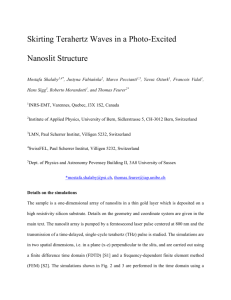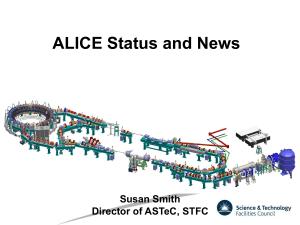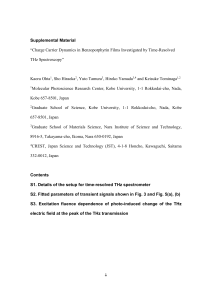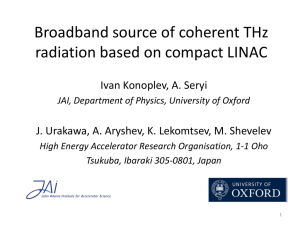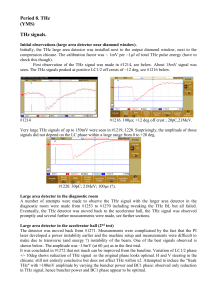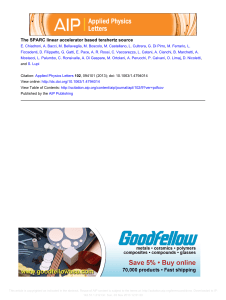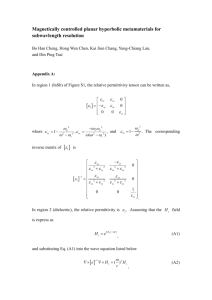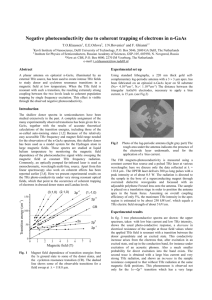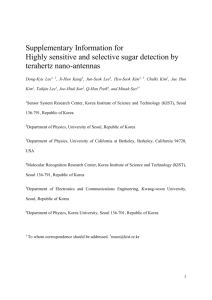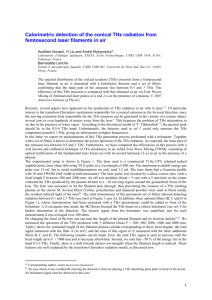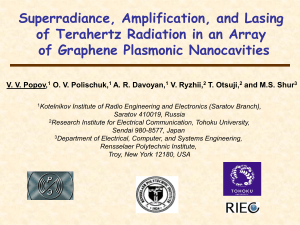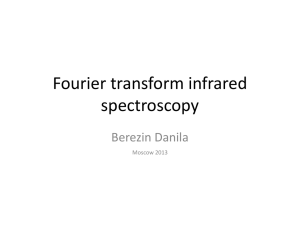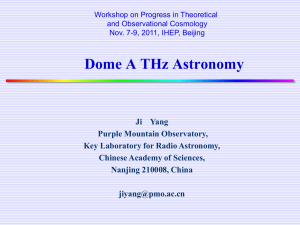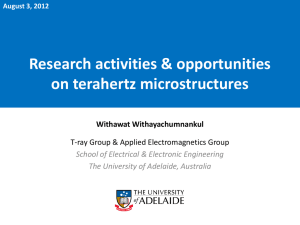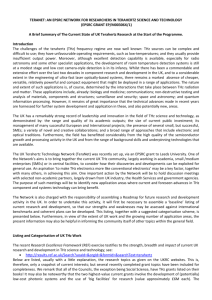The Terahertz Gap
advertisement
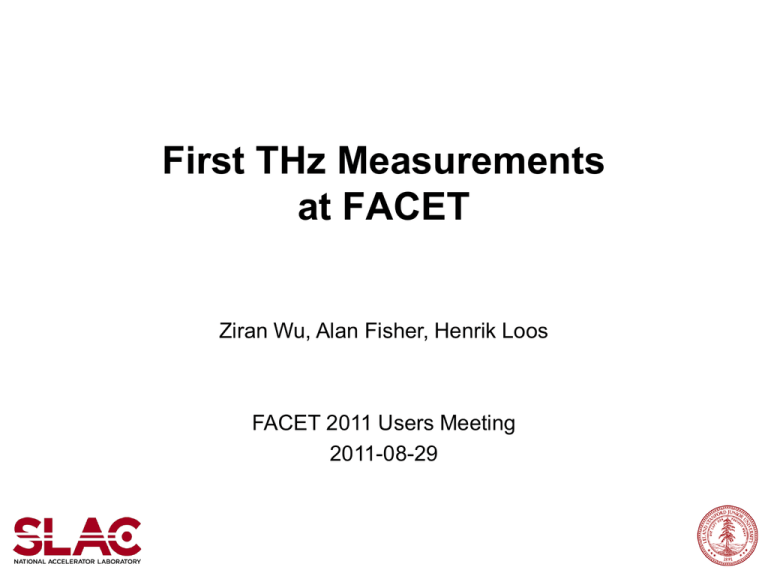
First THz Measurements at FACET Ziran Wu, Alan Fisher, Henrik Loos FACET 2011 Users Meeting 2011-08-29 The Terahertz Gap • “Terahertz” is the gap between mm waves and midinfrared – 1 mm to 10 µm, or 0.3 to 30 THz – Few sources, few optical components, and poor instruments • Pulse energy is difficult to measure: Joulemeters are uncalibrated • Laser-based THz sources are insufficient for pump-probe – Broadband, nearly unipolar pulses are made by: • • • • Photoconductive switching Optical rectification Laser-gas interactions Typical fields of 20 MV/m; pulse energies of 20 µJ – Difference-frequency mixing makes a high-field, few-cycle transient • Fields as high as 10 GV/m; pulse energies again of 20 µJ • We want a quasi-unipolar pulse of ~10 GV/m and >100 µJ Coherent Transition Radiation σe-bunch FACET Beamline High peak-current beam yields strong THz field Bunch length ideal for 0.1 ~ 2 THz generation THz Table Layout THz Table Setup Bunch Length Measurement 0.18 σ = 45 um x0 = -1.56 mm 0.16 Signal/Reference Ratio 0.14 0.12 0.1 0.08 0.06 0.04 -2.2 -2 -1.8 -1.6 -1.4 -1.2 -1 -0.8 Retro-reflector Movement (mm) Electron bunch length σz = 45 um *2 / sqrt(2) = 63.6 um THz Spectrum Peak at ~400 GHz High-end cutoff at ~700 GHz (429 um) σz ≈ 429 um /2π = 68.2 um Beam Size at Focus 60 55 50 50 Sig/Ref Ratio Sig/Ref Ratio 45 40 30 20 40 35 30 25 20 10 15 0 6 8 10 12 14 KE X-scan (mm) 16 18 10 5 6 7 8 9 10 11 12 KE Y-scan (mm) Beam waist (radius): ~3.5 mm horizontal and ~2 mm vertical Consistent with ~1 mm peak radiation wavelength Coincide with e-beam having much larger horizontal size at THz table 13 Simulated Beam Size 50 λ = 1 mm 40 5 Counts y ( mm) 10 Vertical Horizontal 0 -5 30 20 10 -10 -10 0 x ( mm) 10 0 -10 0 x or y (mm) 10 Vertical size 2.4 mm, single peak Horizontal size 2.9 mm, double peak (Can we see it in knife edge scan?) Using sigma_z = 100 um in the simulation Simulated THz Propagation 100 Transmission Distance Electric Field (MV/cm) Radius Vert. polarization λ = 1 mm Field at detector 50 0 -50 Horizontal pol. Vertical pol. -5 0 5 Time (ps) 10 15 Vertical transmission Bunch form factor Radiation spectrum 80 60 40 20 0 0 Main contribution from vertical pol. due to flat beam -10 100 Formfactor (%) e-Beam size 2.1 mm x 75 µm Beam radius -15 10 20 30 40 Wavenumber (cm -1) 50 Comparison with Experiment 1 Measured spectrum Simulated spectrum Water absorption (arb. units) 0.8 0.6 0.4 0.2 0 0 10 20 30 Wave number (cm-1) 40 Low and high roll-off frequencies don’t quite agree Highly depend on e- bunch length Detector responsivity spectrum is desired 50 At Different Bunch Compressions 13 Pyro 1000 Pyro 800 Pyro 600 Pyro 400 Pyro 1000 12 BLEN pyro signal as direct indication of bunch length Filters in the way: Si viewport (3mm) Nitrocellulose BS (2um) Pyro detector (50um crystal and coating) Transverse bunch size 10 Sig/Ref Ratio Larger pyro read Shorter bunch 11 9 8 7 6 5 4 3 -1.6 -1.55 -1.5 -1.45 -1.4 -1.35 -1.3 Delay Stage Position (mm) -1.25 -1.2 -1.15 Diagnostics to Be Done Per-pulse total energy measurement Peak field estimation based on bunch length and focal size A different detector for the autocorrelator? Characterize the current pyro Bunch length and transverse e-beam size variations Downstream foil measurements Possible formation length study Inducing Magnetic Anisotropy Need strong B field for magnetic switching in a thin-film metallic ferromagnet FACET THz beam may provide short and intense enough pulse Sample ready for THz exposure; Arrangement required for single shot per sample (Single-shot operation or chop at sub-1Hz) R&D to Bring THz to Laser Room Ideal for THz-optical pump probe experiment Needs 10s’ of meters THz transport line Relay imaging system with large and frequent OAPs (~200 mm dia., ~5 m EFL, every ~10 m) Experience gain of long-distance THz transportation Possibility of bring laser onto THz table too Thank You ! Curves Silicon Viewport


